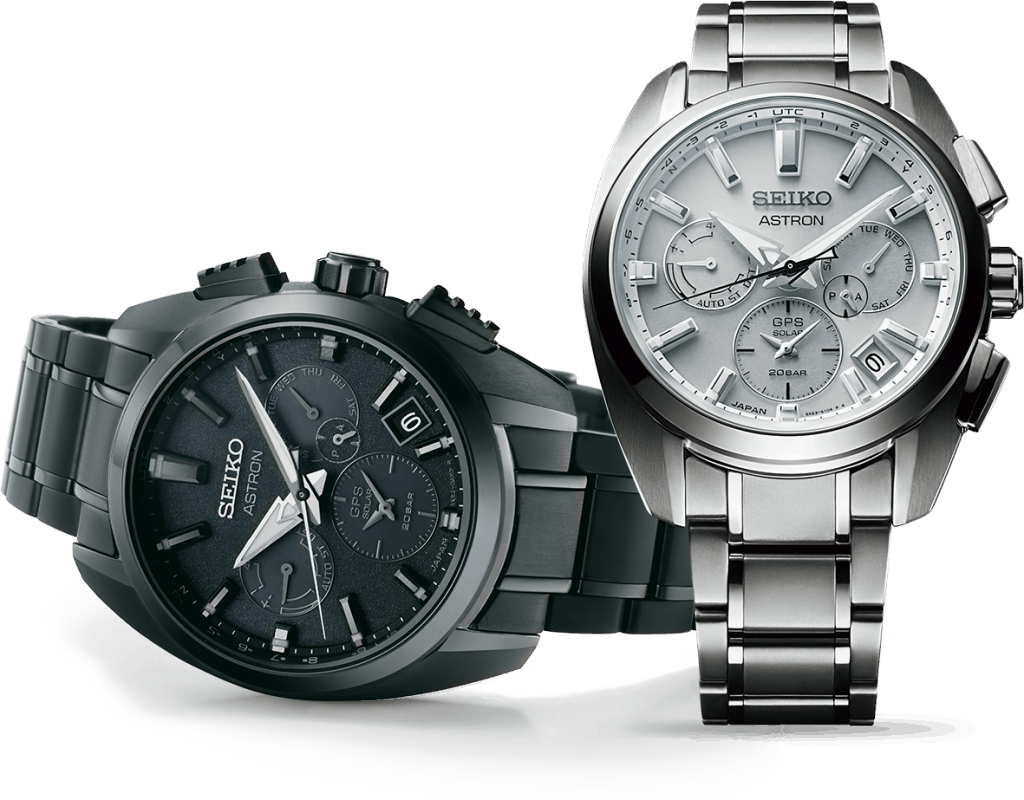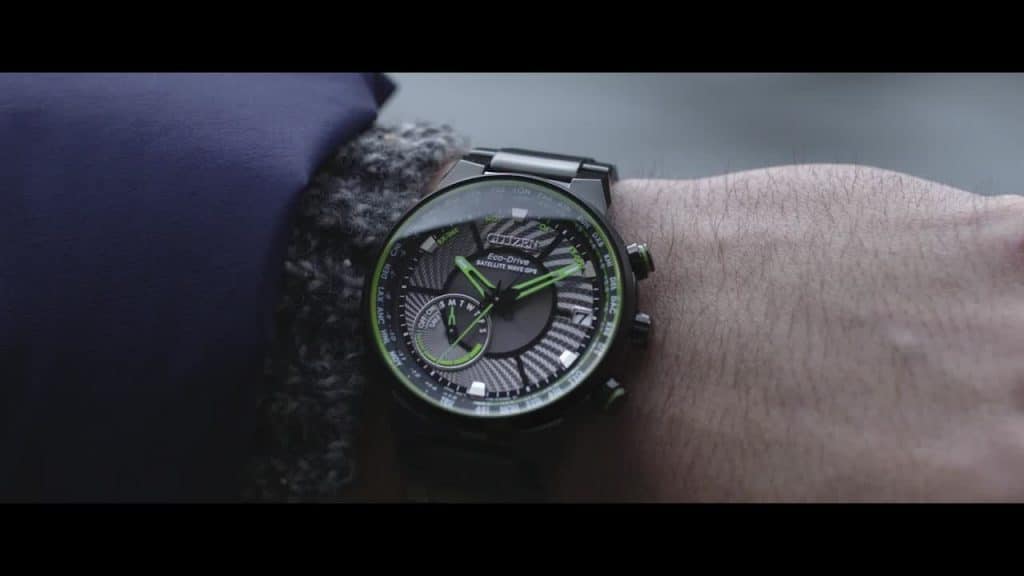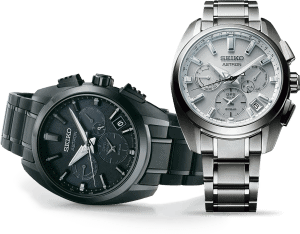If you are interested in knowing how the Seiko Astron vs Citizen Satellite in 2024 then we will explore them more in this article.
The Seiko Astron and the Citizen Satellite Wave are often compared because of their similar color schemes and movement technology.
While both have ultra-modern designs, they have large differences in style and appeal.
If you’re a jet setter looking for futuristic, sporty watches optimized for global travel, the
Seiko Astron and the Citizen Satellite Wave should be in your shortlist.
The Seiko Astron
The first Seiko Astron model utilized quartz movement.
It’s now considered a classic, especially after it put Seiko as one of the world leaders in the watchmaking technology.

The modern Seiko Astron, with its dual-time and multiple time zone function, make it easier for users to travel the world and keep track of time.
It belongs to a line of advanced GPS solar watches from Seiko that combines various technologies to create an efficient and accurate timepiece for handling multiple time zones.
Pros:
- Anti-reflective coating on the crystal
- Has a more durable ceramic bezel
- Automatically updates once a day to keep the watch accurate
- Available in a variety of color themes
Cons:
- More expensive compared to the Satellite Wave
- Large power reserve but can hold barely half of what the Citizen Satellite does
- A little slow in acquiring GPS calculations
The Citizen Satellite Wave
Citizen has been around since 1930 and has made several technological contributions to the horological industry.
They were way ahead of anyone in the development of a light-driven watch which they created in 1976.
They finally made a breakthrough in 1995 and patented the Eco-Drive technology used in the Citizen Satellite Wave.
The Citizen Satellite Wave is designed to constantly keep time in sync.
It has the world’s fastest signal reception for GPS timekeeping.

Pros:
- Faster in acquiring GPS readings by 3 seconds compared to the Seiko Astron
- Incredibly huge power reserve
- More affordable compared to the Astron
Cons:
- Bezel gets easily scratched
- Updates time every 72 hours
- You have to manually configure daylight-saving settings
Head-to-Head: Seiko Astron vs. Citizen Satellite Wave
Here’s a comparison between the two watches from different brands.
Case
The Citizen Satellite Wave measures 43.5mm wide and 12.7mm thick.
The Seiko Astron, on the other hand, measures 43mm wide and 12.2mm thick.
The Astron is somewhat smaller and thinner compared to the Citizen Satellite, but their difference is barely noticeable.
Both the Seiko Astron and the Citizen Satellite both have stainless steel casing.
Different variants of both watches exist, and they have either a brushed or polished stainless steel effect.
Both of them have a tightly screwed, solid case back.
Crown
Both the Seiko Astron and the Citizen Satellite Wave have large crowns that are easy to grip.
The main crown and the crown pushers for controlling the chronograph function are found on the right-hand portion, running from the 1 o’clock up to the 4 o’clock positions.
Bezel
The Seiko Astron comes with a ceramic bezel that looks better and lasts longer than other materials.
High-end watches often use ceramic bezels because of their exceptional quality and resistance to scratches.
The Citizen Satellite Wave, on the other hand, has a metal bezel.
The bezel is durable, but it’s more prone to scratches.
Metal bezels are often available in a wider variety of colors, but they fail to retain the same color sharpness as time passes.
The bezels of both watches have city codes written in them that can be used for configuring the watch with different time zones.
Dial
Both the Astron and the Satellite feature dark, serious-looking dials with a combination of black and blue colors.
The dials are covered with a synthetic sapphire crystal that are virtually scratch-proof.
In terms of hardness, it’s as good as a naturally occurring sapphire.
The Seiko Astron has 24-hour UTC markings on the outer dial, a date window at the 4 o’clock position, a day subdial, a 12-hour subdial, an AM/PM indicator, luminescent index hour markers in blue and white colors, and luminescent hands.
The Citizen Satellite Wave has a chapter ring with UTC markings, a date window, a day subdial, a power reserve indicator, a light level indicator, and luminescent hands and hour markers.
Movement
The Astron and the Satellite both have Japanese quartz movements.
They both feature movements that can be configured using the GPS signal received by the watch.
This is useful if you often fly to different time zones because you can accurately set the watch through GPS technology.
The Citizen Satellite specifically uses a caliber F150 eco-drive technology movement.
Both watches feature a perpetual calendar complication.
The Seiko Astron has around 40 different time zones it can adjust to.
The Citizen Satellite detects the same number of time zones spanning across 27 cities.
Both models use Seiko and Citizen’s respective GPS solar technologies to keep the watch running.
The Seiko Astron holds a battery charge that can last up to half a year.
The Citizen Satellite, on the other hand, takes the upper hand with its power reserve that can hold up to 2 and a half years.
Watches become more inaccurate as the battery capacity decreases.
Make sure you keep these solar-powered timepieces fully charged by exposing them to natural light at least once a week.
Strap
Both the Seiko Astron and the Citizen Satellite are available in different band styles.
Both watchmakers offer rubber, stainless steel, and leather straps to choose from.
Water Resistance
Both the Seiko Astron and the Citizen Satellite Wave have a water-resistance rating of a hundred meters.
Price
The Citizen Satellite Wave is priced at $630.
The Seiko Astron is more expensive at almost $2,000.
Conclusion
Users like the Seiko Astron because of its subtle and modern design.
The dark-themed color combination and sporty watch face design make it highly attractive to customers.
On the other hand, users who prioritize time-telling accuracy go for the Citizen Satellite Wave.
Although the watch updates the time every 3 days, the movement loses/gains only a few seconds per month.
So, if you’re after aesthetics, go for the Seiko Astron.
But if you prefer a more accurate timepiece, the Citizen Satellite Wave is the better choice.
- Seiko Solar vs Citizen Eco-Drive – Compare in 2024
- Seiko SKX007 vs. Seiko SKX013 Comparison Guide
- Seiko SKX007 vs Seiko SKX009 Comparison Guide 2024
- Seiko Shogun vs Seiko Sumo – Comparison Guide 2024
- Seiko SKX007J Vs SKX007K Comparison Guide
- Seiko SKX009 vs SKX175 Comparison – Which is Better Watch
- Seiko Sumo vs Seiko Turtle – Comparing Dive Watch Greats



